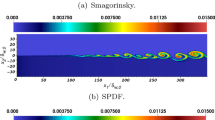Abstract
This study is based on the theory of gas dynamics and uses the Navier-Stokes equations as the governing equations to solve the hypersonic flow problems of the scramjet. For the turbulent flow, we use the Spalart-Allmaras one equation turbulence model, which produces better results for near wall and boundary layer flow field problems. The lower-upper symmetric Gauss-Seidel implicit scheme, which enables results to converge efficiently under steady state conditions, is combined with the anti-diffusive weighted essentially nonoscillatory (WENO) scheme to yield an accurate and efficient simulation tool for an axisymmetric scramjet flow field analysis. Using the WENO scheme’s high-order accuracy and its non-oscillatory solution at discontinuous regions, we can solve the hypersonic flow problems involving complex shock-shock/shock-boundary layer interactions inside the flow path. This simulation procedure is first verified against two existing partial examples to ensure its accuracy, and is then applied to a complete scramjet model with different initial conditions for a full flow field analysis. The aerodynamic data of Mach number, density, static temperature and pressure are obtained and the results discussed. The anti-diffusive WENO scheme produces more accurate resolution of shock and slip lines and their complex multiple interactions than other numerical approaches. This is of crucial importance for the scramjet complete flow field analysis as multiple shock-boundary layer and discontinuities interactions often occur within the long flow path.
Similar content being viewed by others
References
D. Andreadis, Scramjets integrate air and space, The Industrial Physicist (2004).
F. Bouchut, An antidiffusive entropy scheme for monotone scalar conservation law, J. of Scientific Computing, 21 (2004) 1–30.
E. T. Curren and S. B. N. Murthy, Ed. scramjet propulsion, AIAA Progress in Astronautics and Aeronautics, 189 (2001) 447–512.
J. R. Henry, E. H. Jr. Andrews, S. Z. Pinckney and C. R. McClinton, Boundary layer and starting problems on a short axisymmetric scramjet inlet, Compressible Turbulent Boundary Layers, NASA SP-216 (1969) 481–508.
J. C. Huang, H. Lin and J. Y. Yang, Implicit preconditioned WENO schemes for steady viscous flows, J. Comput. Phys., 228 (2009) 420–438.
C. McClinton, A. Roudakov, V. Semenov and V. Kopehenov, Comparative flow path analysis and design assessment of an axisymmetric hydrogen fueled scramjet flight test engine at a Mach number of 6.5, AIAA Paper 96-4571 (1996).
M. Oevermann, Numerical investigation of turbulent hydrogen combustion in a SCRAMJET using flamelet modeling, Aerospace Science and Technology, 4 (2000) 463–480.
K. Pandey and T. Sivasakthivel, CFD analysis of mixing and combustion of a scramjet combustor with a planer strut injector, International Journal of Environmental Science and Development, 2 (2011) 463–480.
P. J. Roache, K. Ghia and F. White, Editorial policy statement on the control of numerical accuracy, ASME Journal of Fluids Engineering, 108 (1) (1986) 2.
C. G. Rodriguez, CFD analysis of the CIAM/NASA scramjet, AIAA Paper 2002-4128, 38th AIAA/ASME/SAE/ASEE Joint Propulsion Conference & Exhibit, Indianapolis, Indiana.
C. J. Roy and F. G. Blottner, Review and assessment of turbulence models for hypersonic flows, Progress in Aerospace Sciences, 42 (2006) 469–530.
L. C. Rumsey, Compressibility considerations for twoequation turbulence models in hypersonic boundary layer applications, NASA-TM-145 (2009).
P. R. Spalart and S. R. Allmaras, A one-equation turbulence model for aerodynamic flows, AIAA Paper 92-257 (1992).
R. J. Ungewitter, J. D. Ott, V. Ahuja and S. M. Dash, CFD capabilities for hypersonic scramjet propulsive flowpath design, AIAA-2004-4131 (2004).
R. T. Voland, A. H. Auslender, M. Smart, A. Roudakov, V. Semenov and V. Kopehenov, CIAM/NASA Mach 6.5 Scramjet Flight and Ground Test, AIAA 99-4848 (1999).
M. J. Wright, K. Sinha, J. Olejniczak, G. Candler, T. Magruder and A. Smits, Numerical and experimental investigation of double-cone shock interactions, AIAA J., 38 (2000) 2268–2276.
D. W. Wilcox, Formulation of the k-ω turbulence model revisited, AIAA J., 46 (11) (2008) 2823–2838.
Z. Xu and C. W. Shu, Anti-diffusive flux corrections for high order finite difference WENO scheme, J. Comput. Physics, 205 (2005) 458–485.
J. Y. Yang, Y. C. Perng and R. H. Yen, Implicit weighted ENO schemes for the three-dimensional compressible Navier-Stokes equations, AIAA J., 39 (11) (2001) 2082–2090.
J. Y Yang, T. J. Hsieh and C. H Wang, Implicit antidiffusive weighted ENO schemes for the three-dimensional compressible Navier-Stokes Equations, AIAA Journal, 47 (6) (2009) 1435–1444.
H. C. Yee, Construction of explicit and implicit symmetric TVD Schemes and Their Applications, J. Comp. Phys., 68 (1987) 151–179.
S. Yoon and A. Jameson, Lower-upper symmetric-Gauss-Seidel method for the Euler and Navier-Stokes equations, AIAA J., 26 (9) (1988) 1025–1026.
Author information
Authors and Affiliations
Corresponding author
Additional information
This paper was presented at the 10th ACFD, Jeju, Korea, October 2014. Recommended by Guest Editor Hyoung-Gwon Choi
Juan-Chen Huang received, in 1995, the Ph.D. from the Institute of Applied Mechanics, National Taiwan University. He is currently an associate professor in National Taiwan Ocean University. His research interests are in the areas of computational mechanics and science.
Jaw-Yen Yang received, in 1983, the Ph.D. from Aeronautics & Astronautics, Stanford University, CA USA. He is currently a University Distinguished Professor in National Taiwan University. His research interests are in the areas of computational mechanics and science.
Rights and permissions
About this article
Cite this article
Huang, JC., Yang, JY., Lai, YH. et al. Simulation of axisymmetric scramjet inlet flow fields using anti-diffusive WENO Navier-Stokes solver. J Mech Sci Technol 29, 1875–1882 (2015). https://doi.org/10.1007/s12206-015-0408-3
Received:
Revised:
Accepted:
Published:
Issue Date:
DOI: https://doi.org/10.1007/s12206-015-0408-3




